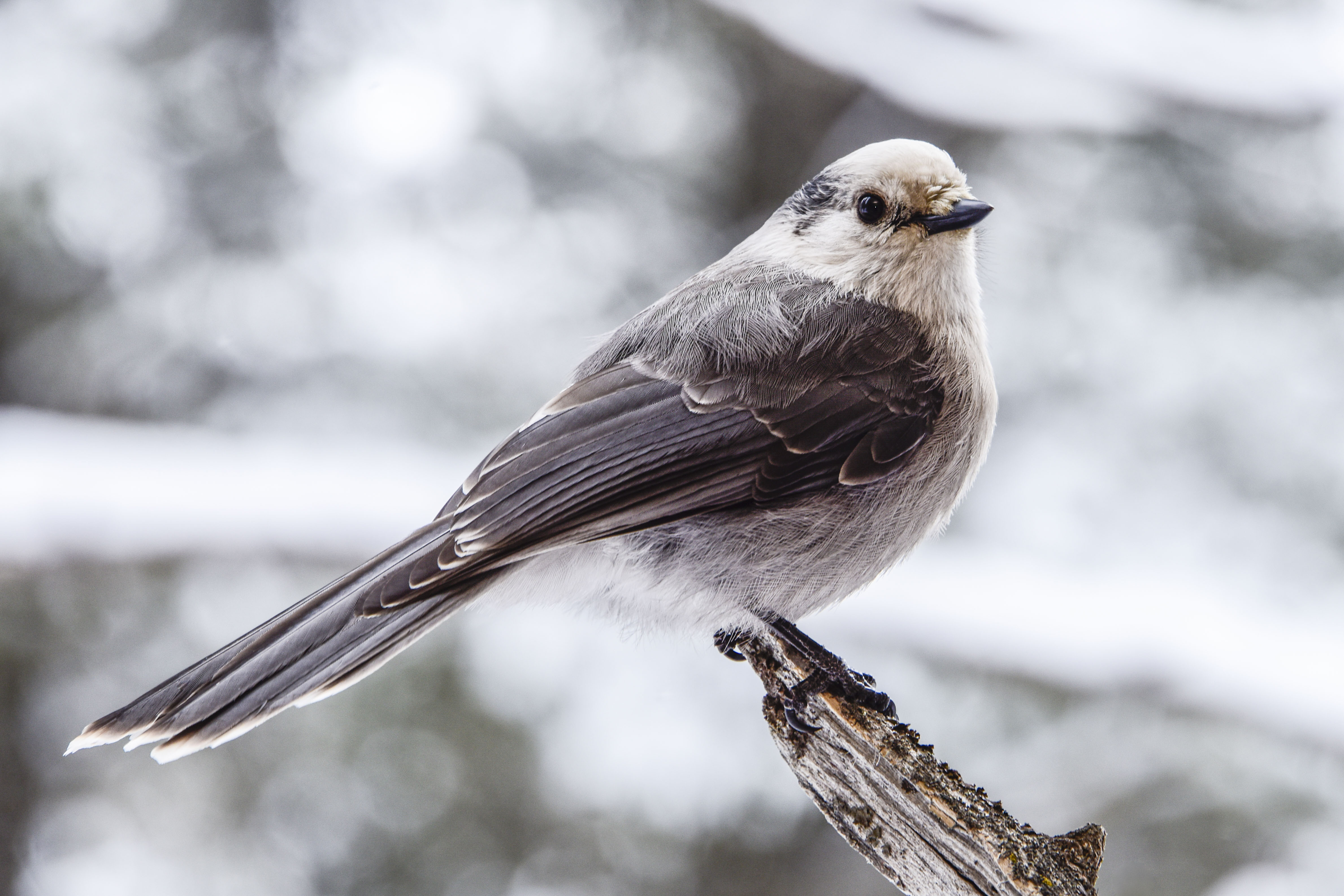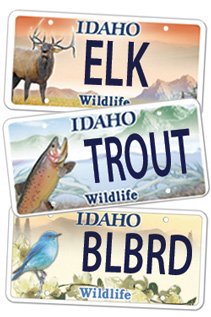Canada Jay

A gray jay, no scratch that, a Canada jay, poses for the camera in Island Park.
In Island Park, feeding birds during the green months is frowned upon. Bears are up and active and they will go to great lengths to get to a birdfeeder full of delicious nuts and berries (from their viewpoint). This often leads to conflicts with humans, conflicts the bear seldom wins. Many people I know anxiously await the onset of winter when bears are asleep so that they can put out birdfeeders for a couple of months.
It sometimes takes awhile to begin attracting birds so I was happy when three species immediately found my offering of peanuts and sunflower seeds. The sunflower seeds are being ignored, but the Stellar’s jay, Clark’s nutcracker and a Canada jay have absconded with every single peanut.
Yes, I said Canada jay, a newcomer in name only. Until this past 18 months, the Canada jay was known as the gray jay—a charming robin-sized forest bird with a light-colored head and chest and gray back and wings and larcenous habits that has earned it the moniker of camp robber. Actually, even that statement isn’t exactly true, for prior to the mid-1940’s it was called the Canada jay, so this is a return to a former name.
Common names and scientific names of wildlife occasionally change when taxonomists, scientists who study the relationships—genealogies if you will—of different species, find connections or lack thereof to other species. They look for differences and similarities and the advent of DNA analysis has challenged accepted norms and assumptions and clarified a lot of relationships with subsequent name changes.
That was the case with the dusky and sooty grouse, once considered a single species, the blue grouse. By 2006, scientists had compiled substantial DNA evidence that indicated that Lewis and Clark, who identified the two as separate species, were correct, and the blue grouse was split back into the dusky and sooty grouse.
Some birds, the gray partridge comes to mind, really didn’t change names, rather adopted a nickname that gained favor and common use. Gray partridge is often called Hungarian partridge or “Hun” although their name appears to have always been, gray partridge, a name that is being used more frequently these days in regulations and popular hunting articles.
However, neither was the case with the Canada jay. It was caught up in intrigue surrounding subspecies names and was sort of lost in time for a while.
The American Ornithological Society, a scientific body that’s responsible for the classification and naming of birds in North America, decided that the subspecies of birds with two or more subspecies would be named after their locale. Thus, if Canada jay was the main species name for Perisoreus canadensis, its subspecies would be called “Alaska Canada jay” or “Oregon Canada jay”. Since it was geographically confusing to have two location names in one name, they changed the main species name to gray jay. About a decade later, when the naming conventions for subspecies changed once again, the AOS admitted that gray jay could return to Canada jay, but this never happened.
Whether oversight or intentional on the part of the AOS, gray jay stuck and was the name I learned this bird by. And what does it really matter? To paraphrase Shakespeare, a gray jay by any other name is just as cool.
Wildlife License Plates
Great news! as of 2024, there are three NEW designs for license plates. They still are bluebird, cutthroat trout and elk, but they are beautiful.
Idaho Wildlife license plates provide essential funding that benefits the great diversity of native plants and wildlife that are not hunted, fished or trapped—over 10,000 species or 98% of Idaho’s species diversity. Game species that share the same habitats (such as elk, deer, antelope, sage-grouse, salmon, trout) also benefit from these specialty plates.
No state tax dollars are provided for wildlife diversity, conservation education and recreation programs. Neither are any revenues from the sale of hunting or fishing licenses spent on nongame species. Instead, these species depend on direct donations, federal grants, fundraising initiatives—and the Idaho Wildlife license plates.
Both my vehicles have Bluebird Plates. I prefer the bluebird because the nongame program gets 70 percent of the money from bluebird plates, but only 60 percent of the money from elk and trout plates - 10 percent of the money from elk plates supports wildlife disease monitoring and testing programs (to benefit the livestock industry) and 10 percent from cutthroat plates supports non-motorized boat access.
Incidentally, in 2014, the Idaho Legislature denied the Department of Fish and Game the ability to add new plates or even to change the name of the elk and cutthroat plates (very specific) to wildlife and fish plates, a move that would have allowed for changing images occasionally and generating more revenue. It would seem that they believe that we Idahoans don't want a well funded wildlife program.
I think it is time we let the Legislature know that Idahoan support wildlife funding and that we would like to see these generic plates come to fruition.
Help Idaho Wildlife
When we traveled across the state in October 2017, we visited most of the Idaho Department of Fish and Game wildlife management areas. Most of the vehicles we saw using the wildlife management areas did not have wildlife plates. Buying wildlife plates is a great way for non-hunters and hunters alike to support wildlife-based recreation like birding.
C'mon folks, let's help Idaho's wildlife by proudly buying and displaying a wildlife license plate on each of our vehicles!
See below for information on Idaho plates. Most states have wildlife plates so if you live outside Idaho, check with your state's wildlife department or vehicle licensing division for availability of state wildlife plates where you live.
And tell them that you heard about it from Nature-track.com!

Wildlife License Plates
Great news! as of 2024, there are three NEW designs for license plates. They still are bluebird, cutthroat trout and elk, but they are beautiful.
Idaho Wildlife license plates provide essential funding that benefits the great diversity of native plants and wildlife that are not hunted, fished or trapped—over 10,000 species or 98% of Idaho’s species diversity. Game species that share the same habitats (such as elk, deer, antelope, sage-grouse, salmon, trout) also benefit from these specialty plates.
No state tax dollars are provided for wildlife diversity, conservation education and recreation programs. Neither are any revenues from the sale of hunting or fishing licenses spent on nongame species. Instead, these species depend on direct donations, federal grants, fundraising initiatives—and the Idaho Wildlife license plates.
Both my vehicles have Bluebird Plates. I prefer the bluebird because the nongame program gets 70 percent of the money from bluebird plates, but only 60 percent of the money from elk and trout plates - 10 percent of the money from elk plates supports wildlife disease monitoring and testing programs (to benefit the livestock industry) and 10 percent from cutthroat plates supports non-motorized boat access.
Incidentally, in 2014, the Idaho Legislature denied the Department of Fish and Game the ability to add new plates or even to change the name of the elk and cutthroat plates (very specific) to wildlife and fish plates, a move that would have allowed for changing images occasionally and generating more revenue. It would seem that they believe that we Idahoans don't want a well funded wildlife program.
I think it is time we let the Legislature know that Idahoan support wildlife funding and that we would like to see these generic plates come to fruition.

"WOW. What a phenomenal piece you wrote. You are amazing." Jennifer Jackson
That is embarrassing, but actually a fairly typical response to my nature essays. Since The Best of Nature is created from the very best of 16 years of these nature essays published weekly in the Idaho Falls Post Register (online readership 70,000), it is a fine read. It covers a wide variety of topics including humorous glimpses of nature, philosophy, natural history, and conservation. Readers praise the style, breadth of subject matter and my ability to communicate complex and emotional topics in a relaxed and understandable manner.
Everyone can find something to love in this book. From teenagers to octogenarians, from the coffee shop to the school room, these nature essays are widely read and enjoyed.
Some of the essays here are my personal favorites, others seemed to strike a chord with readers. Most have an important message or lesson that will resonate with you. They are written with a goal to simultaneously entertain and educate about the wonderful workings of nature. Some will make you laugh out loud and others will bring a tear to the eye and warm your heart.
Readers Write:
"You hit a home run with your article on, Big Questions in Nature. It should be required reading for everyone who has lost touch with nature...great job!" Joe Chapman
"We enjoyed your column, Bloom Where Planted. Some of the best writing yet. The Post Register is fortunate to have your weekly columns." Lou Griffin.
To read more and to order a copy, click here or get the Kindle version
Copies are also available at:
Post Register
Island Park Builders Supply (upstairs)
Barnes and Noble in Idaho Falls
Harriman State Park, Island Park
Museum of Idaho
Valley Books, Jackson Wyoming
Avocet Corner Bookstore, Bear River National Wildlife Refuge, Brigham City, Utah
Craters of the Moon National Monument Bookstore, Arco, Idaho